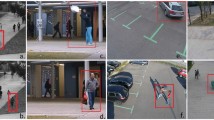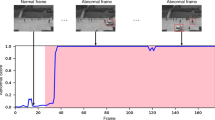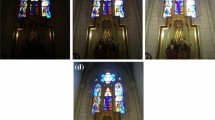Abstract
A method for intelligent video monitoring of abnormal behavior of people is considered that is based on parallel object-oriented logic programming. The main idea of the method consists in the description of sought scenarios of abnormal behavior of people followed by analysis of video images by logic programming means (using first-order predicate logic). The distinctive features of this method are the use of the Actor Prolog object-oriented logic language and the translation of logic programs of intelligent video surveillance into the Java language. In this case, the object-oriented means of the logic language allow one to split a program into interacting parallel processes that implement various stages of video image processing and scene analysis, while translation into the Java language guarantees the necessary reliability, portability, and openness of the software for intelligent video monitoring, including the possibility of using modern libraries of low-level image processing.
Similar content being viewed by others
References
J. Aggarwal and M. Ryoo, “Human activity analysis: A review,” ACM Comput. Surv. (CSUR) 43 (3), 16:1–16:43 (2011).
J. Junior, S. Musse, and C. Jung, “Crowd analysis using computer vision techniques: A survey,” IEEE Signal Processing Mag. 27 (5), 66–77 (2010).
I. Kim, H. Choi, K. Yi, et al., “Intelligent visual surveillance: A survey,” Int. J. Control, Automat., Syst. 8 (5), 926–939 (2010).
A. Artikis, A. Skarlatidis, and G. Paliouras, “Behaviour recognition from video content: a logic programming approach,” Int. J. Artificial Intellig. Tools 19 (2), 193–209 (2010).
A. Skarlatidis, A. Artikis, J. Filippou, and G. Paliouras, “A probabilistic logic programming event calculus,” Theory Practice Logic Programming, No. 9, 1–33 (2014).
V. Shet, M. Singh, C. Bahlmann, et al., “Predicate logic based image grammars for complex pattern recognition,” Int. J. Comput. Vision 93 (2), 141–161 (2011).
V. Shet, D. Harwood, and L. Davis, “VidMAP: Video monitoring of activity with Prolog,” in Proc. IEEE Conf. AVSS 2005 (Como, 2005), pp. 224–229.
S. O’Hara, “VERSA: Video event recognition for surveillance applications,” M.S. Thesis (Univ. of Nebraska at Omaha, 2008).
F. Machot, K. Kyamakya, B. Dieber, and B. Rinner, “Real time complex event detection for resource-limited multimedia sensor networks,” in Proc. AMMCSS 2011 (Klagenfurt, 2011), pp. 468–473.
A. A. Morozov, “Actor Prolog: An object-oriented language with the classical declarative semantics,” in Proc. IDL 1999, Ed. by K. Sagonas and P. Tarau (Paris, 1999), pp. 39–53. http://www.cplire.ru/Lab144/paris.pdf
A. A. Morozov, “On semantic link between logic, object-oriented, functional, and constraint programming,” in Proc. MultiCPL 2002 (Ithaca, NY, 2002), pp. 43–57. http://www.cplire.ru/Lab144/multicpl.pdf
A. A. Morozov, “Logic object-oriented model of asynchronous concurrent computations,” Pattern Recogn. Image Anal. 13 (4), 640–649 (2003). http://www.cplire.ru/Lab144/pria640.pdf
A. A. Morozov, “Development and application of logical actors mathematical apparatus for logic programming of web agents,” in Proc. ICLP 2003, Ed. by C. Palamidessi (Springer, Heidelberg, 2003), pp. 494–495.
A. A. Morozov, “Operational approach to the modified reasoning, based on the concept of repeated proving and logical actors,” in Proc. CICLOPS 2007, Ed. by V. S. C. Salvador Abreu (Porto, 2007), pp. 1–15. http://www.cplire.ru/Lab144/ciclops07.pdf
A. A. Morozov, “Visual logic programming method based on structural analysis and design technique,” in Proc. ICLP 2007, Ed. by V. Dahl and I. Niemel (Springer, Heidelberg, 2007), pp. 436–437.
A. A. Morozov and A. F. Polupanov, “Intelligent visual surveillance logic programming: implementation issues,” in Proc. CICLOPS-WLPE 2014, Ed. by T. Ströder and T. Swift, Aachener Informatik Berichte no. AIB-2014-09 (RWTH Aachen Univ., 2014), pp. 31–45. http://aib.informatik.rwth-aachen.de/ 2014/2014-09.pdf
A. A. Morozov, A. Vaish, A. F. Polupanov, et al., “Development of concurrent object-oriented logic programming system to intelligent monitoring of anomalous human activities,” in Proc. BIODEVICES 2014, Ed. by A. C. G. Plantier, Jr., T. Schultz, et al. (SCITEPRESS, 2014), pp. 53–62.
A. A. Morozov and O. S. Sushkova, The intelligent visual surveillance logic programming Web Site (2014). http://www.fullvision.ru/actor_prolog_2014
R. Fisher, CAVIAR test case scenarios. The EC funded project IST 2001 37540 (2007). http://home pages.inf.ed.ac.uk/rbf/CAVIAR/
A. A. Morozov, A GitHub repository containing source codes of Actor Prolog built-in classes (2014). https://github.com/Morozov2012/actor-prolog-javalibrary
Author information
Authors and Affiliations
Corresponding author
Additional information
This paper uses the materials of the report submitted at the 11th International Conference “Pattern Recognition and Image Analysis: New Information Technologies,” Samara, Russia, September 23–28, 2013.
Aleksei A. Morozov was born in 1968. Graduated from Bauman Moscow State Technical University in 1991. Received his Candidate’s Degree in Physics and Mathematics in 1998. Senior researcher at the Kotel’nikov Institute of Radio Engineering and Electronics, Russian Academy of Sciences. His scientific interests are logic programming, intelligent video surveillance, and processing of biomedical signals (EEG, EMG, and MEG). The author of 90 publications.
Rights and permissions
About this article
Cite this article
Morozov, A.A. Development of a method for intelligent video monitoring of abnormal behavior of people based on parallel object-oriented logic programming. Pattern Recognit. Image Anal. 25, 481–492 (2015). https://doi.org/10.1134/S1054661815030153
Received:
Published:
Issue Date:
DOI: https://doi.org/10.1134/S1054661815030153




